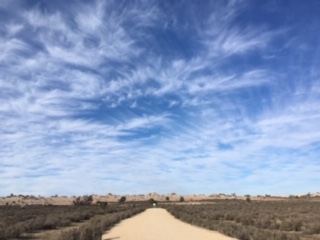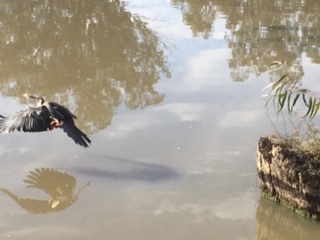An early walk along the Darling River (Barka) to its meeting with the Murray River ( Tongala) was a great way to warm up to the world and for my zoom PD exercise hour. Our exercise trainer had a much more energetic trip in his 36 day kayak trip on the Murray, so it was great to share a bit of our journeys on zoom.
To get to a heartland of Indigenous culture in Mungo National Park required a choice. It was a difficult one because both routes were unknown dirt roads and we had already been spoilt by over 100kms of good dirt roads.
We chose the shortest route which was a mixture of smooth sections but mostly corrugated. It took a lot of concentration but no mishap. Once there, at the edge of the giant but dry Mungo Lake, we let our shaken car rest. There was a quite high embankment of red and white soils covered with solid eroded sandy outcrops formed by the wind blowing this sediment up against this once was lake.
It was here that Aboriginal remains called Mungo man and Mungo woman, from 50,000 years earlier, were found . The feeling here in what seemed the middle of nowhere was quite eerie but giving me a sense of wonder, so quiet, so meditative and on our own. on our very own. As we walked slowly back we could see the trails of vehicle dust witnessing other people who were now coming to make their interpretations of this ancient part of an ancient land.
On the way back we stopped by a walking trail and a more energetic walk through some unusually hilly parts of this rare region. Now we had another choice for our return journey. Our previous journey was not so comfortable so we decided on the alternate track. It was a very unpredictably rough road with holes, bad corrugation and dangerous grids. This meant a much slower trip so a bit of a concern for we didn’t want to be driving on such a wild road after dark. We made it to the very welcome bitumen as the sky turned golden.
I have Parkinson’s and oft’ get tired
It’s easy to sit back, or take a nap,
The downside is it’s hard to get inspired
While setting me a non-desiring trap.
Insidious as this is, I have a choice
My brain however thinks it’s best to rest,
Although it’s smart, it doesn’t have a voice
But mine does tell me – rest not always best.
So I get back up, and find what’s best to do
A walk, a stretch, a move of any sort,
And then my body’s tiredness is all true
Then in this trap it’s harder to get caught.
And when I’m free – there’s possibilities,
To open up, some closed facilities.



Hello again dear friends!
You are covering a lot of territory. I looked at Google maps to trace your present position and route you have taken, and again am taken in by the sheer size of NSW and this vast country of ours. In fact, I just discovered that around 186 Hollands would fit into Australia! It has a somewhat smaller population, but it does give a good idea of the relative densities. Having said that, the significant majority of Australians live in cities and large towns, so saying that 3.2 people live in one square km does not give the full picture.
Loved the photo of the bird and the poem today is a salutary reminder of the ongoing challenges you and other Parkinson’s sufferers have to continually contend with. Interestingly, I asked Janine some moments ago what she is reading (she is doing this for the first time in many weeks) and she mentioned Michael Robotham’s book, ‘Bleed for Me’, which is book four about Joe O’Loughlin, who has got Parkinson’s – Janine said you’ve read them all.
Have been to Broken Hill a few times over the years to run workshops there.
Happy travelling/walking!
Lovely as usual to hear from you both.
The photo took a lot of waiting and encouragement from me, so I am glad it was worth it.
Nearly all, I don’t think we’ve read that one you’re reading.